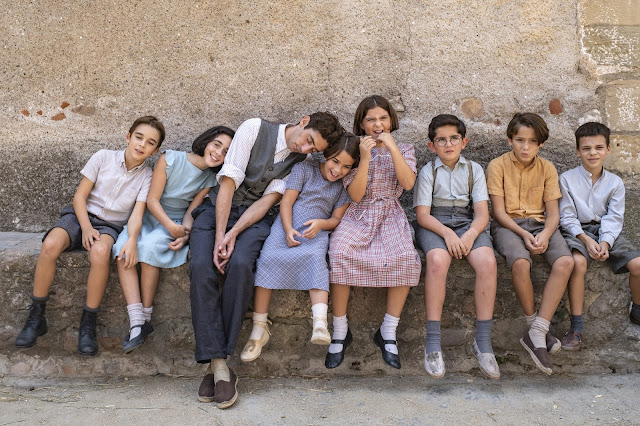Filmax announces the enormous success of the film #TheTeacherWhoPromiseTheSea in Australia, 27 cinemas have raised €300,000 in just a few weeks.
But... Who was going to tell those children from Bañuelos d Bureba and their teacher, Antoni Benaiges that their work and their emotions would travel through Spain, cross the Pyrenees, the Pacific and reach Australia, Germany or Greece? Doesn't it seem like a dream?
An unnamed forest populated by oaks and pines hides at its feet dozens of murdered people and a story that would change my life.
In 2010, the Group of relatives of people murdered in the mountains of La Pedraja fought for its opening. The representative of the group was Miguel Ángel Martínez who, together with his sister Eva and his father Rafael, were looking for a grandfather and father, Rafael Martínez Moro.
My initial idea was to document the phases of the exhumation and interview relatives to carry out work to disseminate and explain what I had experienced there. I wanted that barbarity to be known. My goal was a photography and audiovisual exhibition.
The 2nd Republic decreed that education should be secular, public, co-educational and free. He opened the classrooms to the currents of pedagogical renewal such as that of the French pedagogue Freinet, who proposed a method aimed at "giving the child the word" and the use of printing in the classroom.
When Benaiges arrived in Bañuelos de Bureba, he found a school abandoned by the State: without materials and with few resources other than the good will of the students. The town, small and roadless, lacked electricity, running water and telephone.
One of the first things that Benaiges did when he arrived in town was to order a gramophone and a printing press with the aim of creating a school notebook - as other schools that followed the pedagogue Freinet were already doing - and which, democratically, they named Gestures.
That school published a total of 13 newspapers: 6 d Gestos, 3 d Recreo and 4 more publications: El retratista; Dreams; Burgos folklore, and the most poetic, magical and symbolic notebook of his work in Bañuelos, the one titled The Sea. Vision of children who have never seen him.
The boys and girls of Bañuelos had never seen the sea and, in January 1936, their teacher encouraged them to imagine and describe it. The result was a monographic notebook on the blue immensity. “The sea will be very big, very wide and very deep.” This is how one of the children from this little town in Burgos imagined the sea. The descriptions were repeated: “The sea will be”… “The sea will be…”.
The teacher Antoni Benaiges, who revolutionized his school by giving the word to his students with the help of the Freinet printing press, promised them that they would go to Mont-roig de Camp, to his family's house, to see him for the first time and thus be able to say: “The sea is… The sea is…”.
The first time I had that notebook in my hands was in Benaiges' birthplace, in Mont-roig. In 2010. Elisa Benaiges (the teacher's niece), her son Jaume Aragonés and her cousin Jaume Roigé (also nephew) were waiting for me there.
For 75 years, they have kept the heart of this story.
When I had the El Mar notebook, I knew that that story could not be locked up in that grave or in that box.
We had to fight a battle against oblivion, so that his memory would not be lost forever.
My next stop was the Bañuelos school in Burgos..
It seemed incredible to me to be between those four walls, to observe his blackboard and imagine on it the letters of Emerenciana, one of his students correcting her writing of The sea: «The teacher has told us that he is going to take us to see it and that we will start swimming ». Again, the emotion.
In that same place, I would meet some of the protagonists: the beloved Eladio, Antonio García, Jesús Carranza,... With each photograph I recovered a little piece of that story and saw how I became once again the portraitist of those children, now grandfather d almost 90 years.
Without a doubt, the last reflections of an extraordinary story that had occurred more than 75 years ago and whose protagonists were disappearing very quickly to become a story without living testimonies.
One day we received a message from the granddaughter of a former student. The final part of his email told us: «Take advantage of what you keep in your memory; "The family continues to be captivated and moved by the stories related to their teacher and his tragic death." This is how we met Felisa Viadas.
He was 89 years old. Felisa was one of the most prolific students. Being able to interview a protagonist was of vital importance for the project, since in 2012 there were few alumni alive. He kept the flame of memory intact: "They killed my teacher and he was a good teacher."
By recovering the memory of Benaiges we repair an oversight. There are many works that have been done in recent years: a documentary, different books, a photographic exhibition; a comic; two plays and even a film, #Elmaestroquepromedióelmar and an association.























































